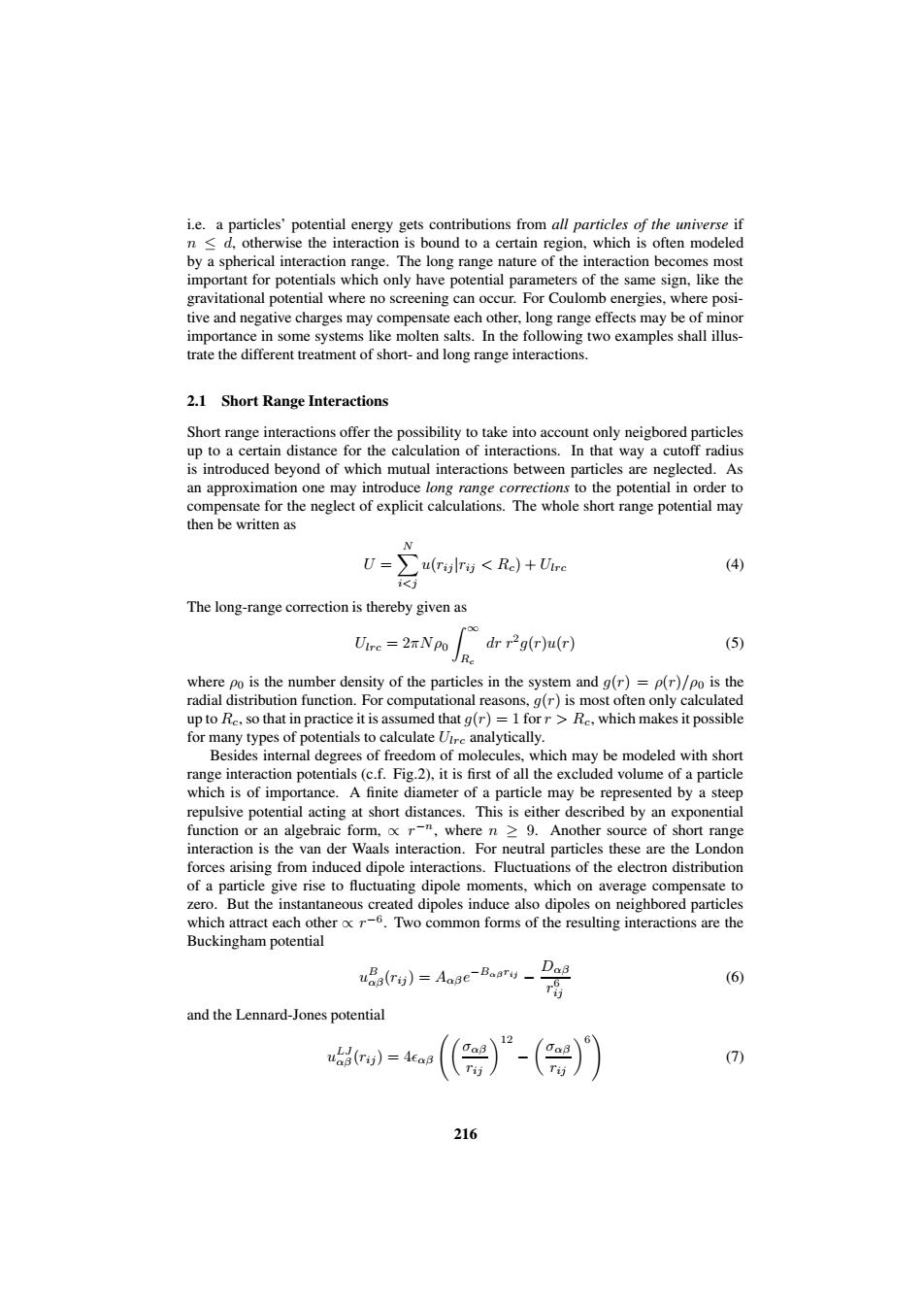正在加载图片...

i.e.a particles'potential energy gets contributions from all particles of the universe if n d,otherwise the interaction is bound to a certain region,which is often modeled by a spherical interaction range.The long range nature of the interaction becomes most important for potentials which only have potential parameters of the same sign,like the gravitational potential where no screening can occur.For Coulomb energies,where posi- tive and negative charges may compensate each other,long range effects may be of minor importance in some systems like molten salts.In the following two examples shall illus- trate the different treatment of short-and long range interactions. 2.1 Short Range Interactions Short range interactions offer the possibility to take into account only neigbored particles up to a certain distance for the calculation of interactions.In that way a cutoff radius is introduced beyond of which mutual interactions between particles are neglected.As an approximation one may introduce long range corrections to the potential in order to compensate for the neglect of explicit calculations.The whole short range potential may then be written as N U=>u(rijlrig Re)+Uire (4) i<j The long-range correction is thereby given as Uire=2πNpo dr r2g(r)u(r) (5) Re where po is the number density of the particles in the system and g(r)=p(r)/po is the radial distribution function.For computational reasons,g(r)is most often only calculated up to Re,so that in practice it is assumed that g(r)=1 forr>Re,which makes it possible for many types of potentials to calculate Uire analytically. Besides internal degrees of freedom of molecules,which may be modeled with short range interaction potentials(c.f.Fig.2),it is first of all the excluded volume of a particle which is of importance.A finite diameter of a particle may be represented by a steep repulsive potential acting at short distances.This is either described by an exponential function or an algebraic form,o r-",where n>9.Another source of short range interaction is the van der Waals interaction.For neutral particles these are the London forces arising from induced dipole interactions.Fluctuations of the electron distribution of a particle give rise to fluctuating dipole moments,which on average compensate to zero.But the instantaneous created dipoles induce also dipoles on neighbored particles which attract each other o r-6.Two common forms of the resulting interactions are the Buckingham potential uag(rij)=Aage-Boary Das r (6) and the Lennard-Jones potential (=)-(=)) (7) 216i.e. a particles’ potential energy gets contributions from all particles of the universe if n ≤ d, otherwise the interaction is bound to a certain region, which is often modeled by a spherical interaction range. The long range nature of the interaction becomes most important for potentials which only have potential parameters of the same sign, like the gravitational potential where no screening can occur. For Coulomb energies, where positive and negative charges may compensate each other, long range effects may be of minor importance in some systems like molten salts. In the following two examples shall illustrate the different treatment of short- and long range interactions. 2.1 Short Range Interactions Short range interactions offer the possibility to take into account only neigbored particles up to a certain distance for the calculation of interactions. In that way a cutoff radius is introduced beyond of which mutual interactions between particles are neglected. As an approximation one may introduce long range corrections to the potential in order to compensate for the neglect of explicit calculations. The whole short range potential may then be written as U = X N i<j u(rij |rij < Rc) + Ulrc (4) The long-range correction is thereby given as Ulrc = 2πNρ0 Z ∞ Rc dr r 2 g(r)u(r) (5) where ρ0 is the number density of the particles in the system and g(r) = ρ(r)/ρ0 is the radial distribution function. For computational reasons, g(r) is most often only calculated up to Rc, so that in practice it is assumed that g(r) = 1 for r > Rc, which makes it possible for many types of potentials to calculate Ulrc analytically. Besides internal degrees of freedom of molecules, which may be modeled with short range interaction potentials (c.f. Fig.2), it is first of all the excluded volume of a particle which is of importance. A finite diameter of a particle may be represented by a steep repulsive potential acting at short distances. This is either described by an exponential function or an algebraic form, ∝ r −n , where n ≥ 9. Another source of short range interaction is the van der Waals interaction. For neutral particles these are the London forces arising from induced dipole interactions. Fluctuations of the electron distribution of a particle give rise to fluctuating dipole moments, which on average compensate to zero. But the instantaneous created dipoles induce also dipoles on neighbored particles which attract each other ∝ r −6 . Two common forms of the resulting interactions are the Buckingham potential u B αβ(rij ) = Aαβe −Bαβrij − Dαβ r 6 ij (6) and the Lennard-Jones potential u LJ αβ (rij ) = 4αβ σαβ rij 12 − σαβ rij 6 ! (7) 216